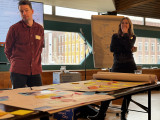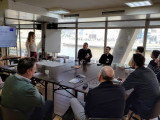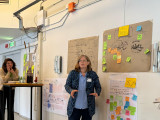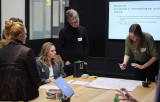Demoday #23: Co-creating with residents in the heat transition

The heat transition is in full swing. Municipalities want their residents off the gas and want them to switch to renewable sources of heat. Unfortunately, heat grids have often led to frustrated residents. Which in turn has led to delayed or cancelled plans for the municipality.
Dave van Loon and Marieke van Doorninck (Kennisland) have looked into the problems surrounding heat grids and came up with a plan. In this Demoday work-session we dived into the problems surrounding heat grids and their plan to solve them. The session was moderated by our own Leonie van Beuken.
Why residents get frustrated with heat grid plans
Involving residents in the planning of a heat grid is difficult. It takes a lot of time and effort and the municipality is often in a hurry. This is why they choose for a compromise in which they already make the plan, but try to involve citizens at the end part. However, this leads to residents not having anything to say in the plans. They can block the plans, but they can’t really make changes. This leads to a lot of dissatisfaction.
This top-down approach doesn't seem to be ideal for involving residents in the heat transition. That's why Kennisland is working on developing a plan for early collaboration with residents in the heat transition of neighbourhoods, with a focus on connecting with the community's concerns.
They have seen that this kind of approach can be successful by looking at the K-buurt in Amsterdam-Zuid-Oost. In the initial stages, the first plan for the K-buurt didn't gain much traction. However, when they shifted towards a more collaborative approach, people felt empowered to engage, leading to a more meaningful participation process. Instead of traditional town hall meetings, discussions took place in community spaces like the local barber shop. This shift towards genuine participation and co-creation has resulted in a much-improved end product, one that residents truly support and believe in.
The plan for co-creation in the heat transition
The plan that Kennisland came up with consists of a few key points that are necessary for success:
• Engage with residents early on in the process.
• Also consider other issues in the neighbourhood. There might be more pressing concerns for the residents themselves.
• Ensure accessibility for everyone to participate.
• Truly collaborate on developing a list of requirements.
• Harness creativity.
• Work in a less compartmentalized manner.
They aim to form a neighbourhood alliance and organize a community council. Together a plan can be made for the neighbourhood that all residents can get behind.
This plan might take a bit longer at the start, but that investment in time will pay itself back in the end.
SWOT analysis of co-creation plan
After Dave and Marieke explained their plan we did a SWOT analysis with the group. We looked at the Strengths, Weaknesses, Opportunities, and Threats of the plan.
The main strength that was pointed out was the ability to make a plan together with the residents. The residents experience the neighbourhood differently than a government official, which makes the final plan more beneficial to everyone.
The weaknesses the group saw in the plan were mainly that this could potentially slow down the process. Should we maybe do less participation instead of more and use force to get this heat transition going?
There were a lot of opportunities identified for this plan. The quality of the plan (and the neighbourhood) can greatly increase. By slowing down at the start we can actually accelerate and improve the neighbourhood on many levels. This plan also offers a great learning experience.
Finally, we went into the threats. One of the big threats that was pointed out was the lack of trust. If residents don’t trust the municipality and the process then it will never be possible to let this plan succeed. The explanation to residents also needs to be understandable. The explanation around a heat grid can get technical very quickly, and residents often don’t have the background to understand everything. The last threat that was pointed out was that if you get a lot of input from the residents for the plan, you also have to do something with that, and still be realistic. You have to work hard to manage expectations.
We completed the session by asking the participants if they knew any partners and places to collaborate with for this plan, or if they had any other ideas to make this plan successful.
We would now like to ask the same questions to you! Do you know someone who would like to partner up with Kennisland, do you know a place where this plan can be tested, or do you have any other ideas? Let us know by contacting me at noor@amsterdamsmartcity.com.






